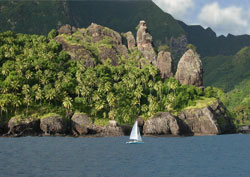Fatu Hiva
 Why Fatu Hiva
in the Marquesas Islands
in Polynesia is special
Why Fatu Hiva
in the Marquesas Islands
in Polynesia is specialFatu Hiva attracts adventure travelers for its refreshing isolation and lush tropical, craggy landscape. The island is the remains of two calderas of once mighty volcanoes.
Fatu Hiva tips and insights
Highlight
The Bay of Virgins (see photo) is the tourist jewel of Fatu Hiva.
Omoa and Hanavave
The village harbors in Omoa and Hanavave are minuscule. Sometimes they are crowded with yachts, forcing would-be visitors to sail away without stepping foot on Fatu Hiva. Rough seas and strong gusts are other nautical barriers.
Thor Heyerdral
The Norwegian Thor Heyerdral (of Kon-Tiki fame) and his newlywed wife lived primitively on Fatu Hiva in Polynesia for over a year in the 1930s. He relates his initial bliss and eventual disillusionment in his Back to Nature book.
People and accommodations
Fatu Hiva has barely 600 inhabitants. They are exceptionally warm and welcoming to visitors. Accommodations are limited and mainly consist of pensions.
Crafts
The two best bring-home crafts are traditional wood carvings and topa cloths (beaten bark painted with intricate tattoo-like drawings).
Location
Fatu Hiva (also spelled Fatu Iva) is the southernmost island of the remote Marquesas Islands group in French Polynesia.
Getting there
It has no landing strip. Except for a rare helicopter, boats are the only means of access. Your options include a short stop off a cruise ship or private yacht - or from the Aranui passenger-freighter, which calls once every three weeks.


